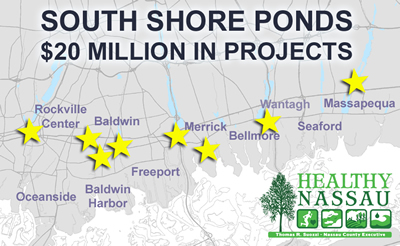|
Invasive Species
The definition of an invasive species is a plant or animal that is non-native to the ecosystem, and whose introduction causes or is likely to cause economic or environmental harm or harm to human health. In the latter case, the harm must significantly outweigh any benefits. Many of Long Island’s species of plants and animals are non-native. Only a small percentage of these cause the harm necessary to be deemed invasive. Invasive plants and animals are one of the most serious and pervasive threats to native species and ecosystems on Long Island. Invasives spread into natural areas and out-compete, damage and often eliminate native species, and the wildlife that depend on them. Unchecked, invasives will disrupt ecosystem patterns and processes, such as hydrology, nutrient cycling, frequency and intensity of wildfires (necessary to some ecosystems on Long Island), natural succession, and soil erosion. Every ecosystem on Long Island, whether terrestrial or aquatic, is threatened by these biological invasions. Nassau County is focused on managing invasive species through prevention of new invasions, early detection and rapid response to new invasions, and control or eradication of existing invasions. The four components of an invasive species program are:
Nassau County Legislature passed and the County Executive signed Local Law 22 - 2007 to ban the sale or distribution of 63 harmful invasive plant species within the County. The following species are currently included on the County's "Do Not Sell List."
South Shore Ponds - $20 Million in Projects In addition to invasive species management, Nassau County has implemented $20 million worth of pond improvements that are either completed or are in construction along the south shore. Nassau County has and will be receiving reimbursement from New York State in the amount of $3.7 Million. The projects include:
Milburn Pond: Dredged approximately 14,000 cubic yards of sediment, construction of a sediment capture basin, new pond walls in some areas and landscaped banks in others. New pathways, benches, trash receptacles, pond aeration and landscaping features were also included in the project. Project cost: $3.3 million, of which $437,500 were a NYS Clean Water/Clean Air Bond Act award
Tanglewood Pond and Preserve: Dredged main pond as well as rehabilitation of two sedimentation basins. New brick paver pathways surround the pond leading to a fishing pier. A nature trail through a wooded preserve area includes several small bridges over a small stream. The pond edge was replanted with new native wetland grasses plants and shrubs including cardinal flower, cattail and pond aeration were added. Project cost: $1.2 Million, of which $600,000 were a NYS Clean Water/Clean Air Bond Act award Loft’s Pond: Hydraulic dredging of several thousand cubic yards of sediment from the pond, aquatic harvesting of aquatic vegetation, new pond shoreline plantings, pathways, benches, trash receptacles. A new boardwalk over water was also featured as well as a new gazebo and park lighting. Project cost: $1.2 Million, of which $400,000 were a NYS Clean Water/Clean Air Bond Act award Silver Lake: Hydraulic dredging of several thousand cubic yards of sediment from the pond, aquatic harvesting of aquatic vegetation, new pond shoreline plantings, pathways, benches, trash receptacles, and lighting. Project cost: $1.2 Million, of which $200,000 were a NYS Clean Water/Clean Air Bond Act award Mill Pond: Hydraulic dredging of several thousand cubic yards of sediment from the pond, aquatic harvesting of aquatic vegetation, new pond shoreline plantings, pathways, benches, trash receptacles. Project cost: $1.2 million, of which $300,000 were a NYS Clean Water/Clean Air Bond Act award Roosevelt Pond: Constructed a sedimentation basin, new pond wall, some hydraulic dredging, planted native wetland grasses and plants as well as upland shrubs along the shoreline. New pathways, benches, trash receptacles and lighting were also added. Project cost: $2.2 Million, of which $437,500 were a NYS Clean Water/Clean Air Bond Act award Massapequa Preserve: This major renovation project is currently underway. It is comprised of multiple components, including streamflow augmentation, stormwater treatment and bioengineering treatments of the streambank along Massapequa Creek. Partial dredging of the Massapequa Reservoir will occur later this year. Projected total cost: $8 million dollars, of which $1.3 Million were a NYS Clean Water/Clean Air Bond Act award |
||||||||||||||||||||||||||||||||||||||||||||||||||||||||||||||||||||||||||||||||||||||||||||||||||||||||||||||||||||||||||||||||||||||


